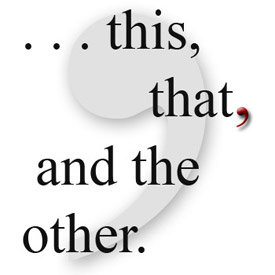Saturday Sidetrack: Dead Commas, now?
Right, so this has little to nothing to do with seurity at all, but since it’s Saturday and there seems to be little else happening in the world of guard forces, alarm systems and security tips and tricks.
of guard forces, alarm systems and security tips and tricks.
The “Oxford Comma” is rumored to be deceased. Disconcerting, right? The question on everyone’s lips, as far as we can tell is “The whatnow comma?” It was the question that first popped into our heads, at least, followed closely by “There are several comma species?”
Here’s the deal: The “Oxford Comma” is not a special comma in itself, it’s a use of the comma. Yes the normal comma. It goes a little something like this: You create a list of items in a sentence. We’ll use “a, b, c”, and the occurrence of the Oxford comma is before the last “and” in the list. For example:
“You have to bring a, b, and c with you.” The comma after the “b” is the Oxford comma, and has now been deemed obsolete by the University of Oxford Public Affairs Directorate’s Writing and Style Guide, which now encourages its writers to avoid the comma usage. Exceptions, you ask? Of course! The comma should be used “thoughtfully”, such as in this example:
In
cider, real ales, meat and vegetable pies, and sandwiches
the absence of a comma after pies would imply something unintended about the sandwiches.
And we wouldn’t want to imply anything unintended about sandwiches, that’s for sure.
Some more info, from the style guide and here:
Here’s an explanation from the style guide: “As a general rule, do not use the serial/Oxford comma: so write ‘a, b and c’ not ‘a, b, and c’. But when a comma would assist in the meaning of the sentence or helps to resolve ambiguity, it can be used – especially where one of the items in the list is already joined by ‘and’ [for example]: They had a choice between croissants, bacon and eggs, and muesli.”
Some more resources for those interested in writing and style and commas and such:
The Chicago Manual of Style (CMS) has the following nifty things to help you:
- tools, such as sample correspondence, proofreaders’ marks, and manuscript preparation instructions

"The Elements of Style" - Chicago-Style Citation Quick Guide for students, researchers, and writers
- Chicago Style Q&A, entertaining and informative answers to readers’ questions
The Elements of Style (1918), also known as Strunk & White, by William Strunk, Jr. and E. B. White, is a prescriptive American English writing style guide comprising eight “elementary rules of usage”, ten “elementary principles of composition”, “a few matters of form”, a list of forty-nine “words and expressions commonly misused”, and a list of fifty-seven “words often misspelled”.
In 2011, Time magazine placed the book in of the 100 best and most influential books written in English since 1923.
